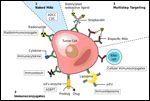Light-Induced, Specific Killing of Cancer Cells
Researchers have developed a novel way to molecularly target and kill cancer cells, called photoimmunotherapy. The method uses a monoclonal antibody against the epidermal growth factor coupled to a near-infrared dye. The result is a target-specific photosensitizer that causes specific cell death of cells bound by the antibody when NIR light is applied.
In a study published in Nature Medicine (DOI: 10.1038/nm.2554) researchers from the Molecular Imaging Program at the NCI have developed a novel way to molecularly target and kill cancer cells, called photoimmunotherapy (PIT). The method uses a monoclonal antibody (mAb) against the epidermal growth factor coupled to a near-infrared (NIR) dye. The result is a target-specific photosensitizer that causes specific cell death of cells bound by the antibody when NIR light is applied. The team at the NIH has been working on this “activatable” fluorescence imaging and conjugate technology for the last five years.

Monoclonal antibodies for cancer
Hisataka Kobayashi, of the NCI and lead author of the work, says that PIT has the potential to treat patients with scattered small metastasis and lung cancer; patients that are currently incurable. PIT may also be used to treat circulating tumor cells, cells that are left in the body after surgery, which are difficult to detect and eradicate. “I believe PIT can have a potential to change cancer therapy,” said Kobayashi.
The Background
Antibodies have previously been coupled to radionuclides and chemical and biological toxins but were found to have many dose-limiting toxicities. The currently described technique specifically targets the photosensitizer, avoiding off-target effects that can cause distribution throughout the body and result in high toxicity to normal tissue. This property is likely to be highly important for future clinical development.
While previously developed light-based treatments have been developed, the main difference with the antibody-NIR dye technique is that while photosensitizer may still be distributed throughout the body, it is only active after binding to the cell membrane of target cells and only upon being exposed to activating IR light. The unbound antibody conjugated to the IR700 dye does not contribute to phototoxicity. This technique minimizes exposure of non-cancerous tissue and allows a non-invasive way to monitor the therapeutic effects of excitation light as the agent emits a diagnostic fluorescence.
The researchers conjugated their NIR dye to either trastuzumab, targeted against human epidermal growth factor receptor 2 (HER2), or panitumumab, against human epidermal growth factor receptor 1 (HER1). Other antibody-dye conjugates will likely be developed.
The Results
Using the new NIR-dye couples antibody, researchers showed that apoptosis was induced immediately after irradiation of the antibody-bound target cells with NIR light in a tissue culture model. To observe distribution in vivo, a xenograft tumor mouse model was used, showing specific localization to tumor cells and some accumulation of catabolized and unbound dye in the bladder, according to the authors.
This technique can be delivered within several centimeters of otherwise inaccessible tumors deep in the body as NIR light excitation allows penetration of at least several centimeters into tissue. Delivery of NIR light can be achieved using fiber-coupled diodes with diffuser tips, according to the researchers, as has been done to treat brain tumors and peritoneal ovarian tumors.
What’s Next
Kobayashi and his team are eagerly preparing and applying to start phase 0 and phase 1 trials with mAb-IR700, including beginning dialogue with the biopharma companies that manufacture the antibodies. The have already performed acute and sub-acute safety studies in mice to prepare for the first in-human safety trials.
The team is also working to optimize the photoimmunotherapy technique and to try other antibodies for conjugation to the infrared dye. Antibody dosing to establish a better PIT therapy regimen as well as testing fractionated NIR exposure are at the top of the list. According to Kobayashi, PIT can kill 99% of cancer cells within 10 to 15 minutes of light exposure, and the researchers are now also studying methods to monitor early therapy affects. They would also like to test PIT for metastasis and to target circulating tumor cells or hematological cancers in addition to testing other targets for which antibodies are available.
“PIT can [be applied] to any antibodies, even [those] less specific than FDA-approved ones because PIT does not damage any cells without irradiating appropriate dose of NIR light. Therefore, we can control PIT systemic or local, high dose or low dose, surface or deep by controlling dose of antibody conjugate and exposure of NIR light,” Kobayashi explained.
The PIT technology can be expanded to other non-cancer applications as well. The NIH researcher added that the PIT method is the first theoretical method for removing a specific population of cells from either the systemic or localized part of the body. Therefore, according to Kobayashi, the team believes it could also be applied to other diseases, to eliminate auto-immune related cells in patients with auto-immune disease such as rheumatoid arthritis.